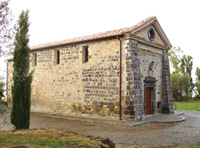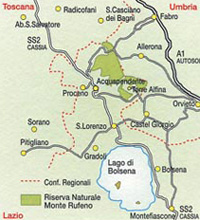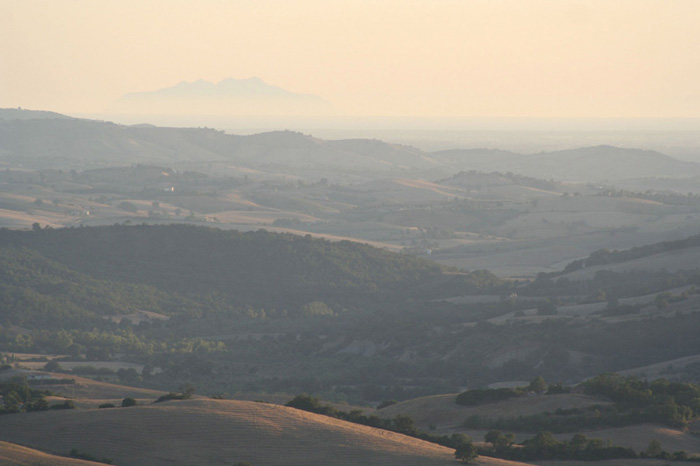Bolsena Lake | Lago di Bolsena |
| The very ancient town of Bolsena sits on the shores of Italy's largest lake, Lago Bolsena, in Viterbo Province in the north western corner of the Region of Lazio Roma. Lake Bolsena is the largest volcanic lake in Italy. The lake, which is about 12 km long and 14 km wide, is filled with remarkably clear, almost potable water, sits in the crater of a long-extinct volcano. The lake is surrounded above all by the mountain range of Vulsini Mount. A road of about 60 Km surround it, and the outlook offered is always wonderful, both if you are near or far from the lake. The lake itself has a diameter of 60 km and is surrounded by some splendid towns, we suggest to visit Montefiascone, Marta, Cività di Bagnoregio and Capodimonte. Other pleasant small towns rising on the hills all around the lake are San Antonio, Gradoli, Grotte di Castro and Bolsena. In the early Renaissance, most of these places became the favourite holiday resorts of the powerful Farnese family. The two small islands in the lake (the Bisentina and the Martana islands) are the remains of volcanic cones. The Bisentina is especially noteworthy for its beautiful natural environment and for its ancient monuments, among which is the chiesa di Santi Giacomo and Cristoforo. The Via Francigena |
||
| The Via Francigena, also known as the Via Francesca, Franchigena or Romea, is the road taken by pilgrims in the past to reach the three main religious destinations of Christianity since the Middle Ages: Santiago de Compostela, Rome and Jerusalem. This route in Lazio passes by the remains of the Etruscans, and is the crossroads and collector of all the other roads travelled by the pilgrims, including those towards Jerusalem. They passed by here after going to the Vatican to receive the Testimonium, the precious document showing that they had completed the pilgrimage The map of the northern Via Francigena starts along the Via Cassia from Proceno, a postal station founded by Porsena in the 6th century BC. Then we come to Acquapendente, where the main monument is the Santo Sepolcro church. Crossing through the territory of Grotte di Castro, rich in Etruscan tombs, we find San Lorenzo Nuovo. The existing town, famous for its octagonal square, takes its name from the rebuilding undertaken by Pope Clement XIV in 1774 to transfer the population from the older town. The medieval town of Bolsena, deriving from the ancient city of Volsinii, is surrounded by the shores of Lake Bolsena. The Via Francigena then goes to Montefiascone, after passing by the church of San Flaviano, standing alone at the foot of the medieval town. |
||
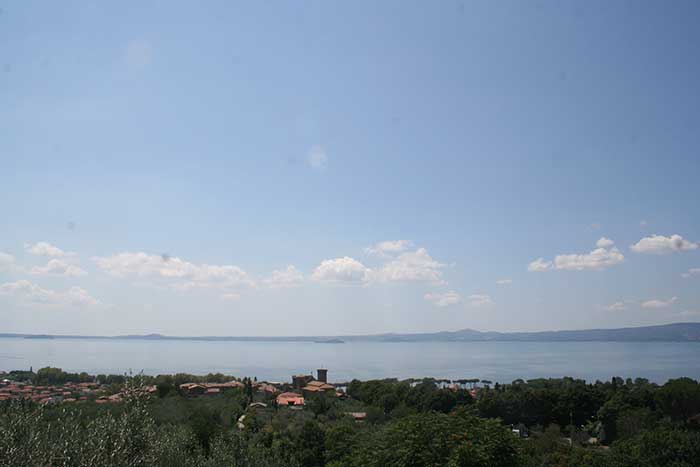 |
||
Bolsena Lake | Lago di Bolsena |
||
Bolsena |
||
Bolsena is one of the principal centres in Alta Tuscia Laziale and easily the most important town of the Bolsena Lake. The Romans built this charming little town on the shore of Lake Bolsena in the 3rd century BC, after the conquest of the Etruscan town of Orvieto (Velzna). After the destruction of Velzna, the new town Volsinii was rebuilt near the lake. Situated on the Roman road Cassia, Volsinii soon became a flourishing town thanks to its strategic position. At the end of the Roman Empire, the town was slowly abandoned. In the Middle Ages Bolsena attracted the attention of the Christian world because of a eucharistic miracle which took place inside the basilica of Santa Cristina in 1263. The Basilica of Santa Cristina with the catacombs and the Cappella del Miracolo is well worth a visit. The relics of Cristina are kept under a small altar in a modern shrine. Also interesting are the archaeological excavations at Poggio Moscini and a medieval castle which houses a nice museum with finds from the Etruscan- Roman period to the Middle Ages. Map of Bolsena url | pdf
|
|
|
| San Lorenzo Nuovo is located on the northern side of Lake Bolsena's crater rim. It dominates the lake basin on one side and the valley of the Acquapendente on the other side, at the crossing of the ancient Via Cassia (now state road 2) and the via Maremmana (state road 74). San Lorenzo Nuovo is famous for the harmonious symmetry and linearity of its streets, due to Francesco Navone. San Lorenzo Nuovo is famous for the harmonious symmetry and linearity of its streets, due to Francesco Navone.
It has a large octagonal central area which is the heart of the community and a monumental space onto which faces the Church of San Lorenzo Martyr. |
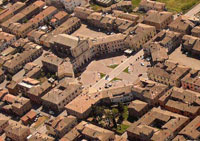 |
|
| The Necropolis of the Pianezze is situated just outside the town of Grotto di Castro. This interesting archaeological site houses numerous tombs that date back to the period between the 7th century and 6th century B.C, including the very famous “Tombe Rossa” (Red Tomb). Museo Civico Archeologico di Grotte di Castro The Museo Civico Archeologico E Delle Tradizioni Popolari is located in Lazio, Italy, and occupies the ground floor and basement of the residence of the Podesta (mayor) from the eighteenth century. It has two separate sections: one archaeological and one dedicated to local folk traditions. It is open every day of the week except Mondays. Capodimonte Capodimonte is a little town on the western side of the Lake of Bolsena. Paulus III tried to conquer also the eastern side of the lake with Montefiascone, because this would have given him control of the Via Cassia the most important route to Rome from the north. He had to content himself with Capodimonte, where he built another palace. Capodimonte is close to one of the two islands in the lake (Isola Bisentina) where Paulus III built a little palace and a church. The Bisentina isle (0.17 square km. of surface) is an interesting touristic excursion for those people who go to Capodimonte. Isola Bisentina |
||
With an area of 17 ha (42 acres), Bisentina is the largest island, and is accessible via a ferry service from Capodimonte. On the island are groves of evergreen oaks, Italian gardens, and various monuments: the church of Saint James and Saint Christopher with its cupola built by the architect Jacopo Barozzi da Vignola; the Franciscan convent; the Rocchina, a small temple dedicated to Saint Catherine. The latter was constructed in an octagonal floorplan by Antonio da Sangallo, over an Etruscan colombarium previously erected on a rocky outcrop on the lake. Another monument, the chapel of the Crucifix, contains frescos of the fifth century. The Malta dei Papi, a former prison for ecclesiastics found guilty of heresy, was shaped from a small cave with a trapdoor placed at a height of 20 m (66 ft).
|
||
| Marta Marta, just a few miles south of Capodimonte, retains a very nice coat of arms of Paulus III at the entrance of the little town. A little fortress protects the town. |
||
| Latera | ||
| Latera, a gorgeous town in the province of Viterbo, lies amid splendid countryside cloaked in chestnut trees. This small town in Upper Tuscia, between Tuscany and Lake Bolsena, is located in a broad basin that was once known as Val di Lago. Latera is seen as a small gem of art and culture, custodian of historic palazzi, which once housed significant political figures, monuments celebrating the events of the past and churches of absolute unique beauty. The town is a typically medieval town, with an Etruscan and Roman past. Marcus Aurelius is believed to have been named Emperor here. Its most stable period of rule was under the Farnese (until 1668), who built Palazzo Ducale in Piazza della Rocca and a town aqueduct. Also note the two fountains. The historic center is a maze of streets, steps and archways, above which rises the elegant Latera belltower. Just before the main square stands the church of San Clemente, the principal sacred building of the town. It was built in the 15th century and was the original Baptismal seat, the only one in the province of Viterbo. Designed in a very simple way, it is embellished with a precious fresco depicting the Crucifixion, a 15th century stone tabernacle and a painting depicting La Madonna del Carmine e San Carlo. The slender Borromini-style bell tower dates to 1790. Inside the church there are paintings from various different eras, a lovely wooden crucifix, the baptistery (1591) and an organ made by Angelo Morettini in around 1865. There are many other churches in and around the town, among them the Chiesa Sant'Eligio (Madonna della Cava), possibly the oldest building in Latera, and the Chiesa di San Sebastiano, a small building dating back to the 1400’s that astounds visitors with splendid examples of architecture, numerous works of art and the two wonderful frescoes, L’Immacolata Concezione and Gli Angeli e San Sebastiano. The Palazzo Farnese dates back to the 15th century. The building is divided into an older section, built in the 16th century and a more modern section, rebuilt in a more recent age. On its portal you can admire a religious coat of arms, whilst inside, there are arches and columns; as well as walls richly decorated with precious frescoes dating back to the 16th century. The town's farming traditions are documented in the fascinating Museo della Terra. Comune |
 Latera |
|
| Montefiascone |
||
| Montefiascon is located on a hill on the southeast side of Lake Bolsena. The town flourished in the Middle Ages around a fortified rock and in the 12th and 13th century it acquired importance as a safe haven for the popes, often forced to flee from the Papal Palace of Viterbo. The Cathedral, the Chiesa di Santa Margherita(1519) is one of the earliest structures by Michele Sanmicheli. The cathedral is an extraordinary religious structure embellished with an enormous cupola, famous all across Italy. Built in the 15th century, it is home to an absolutely splendid wooden Crucifix and the relics of the saint in which the church was dedicated to. The relics of the martyr Flaviano, killed in 361 during the persecutions of Giuliano l’Apostata, are kept in the church of San Flaviano a Montefiascone. The present building was built between the 12th and 14th centuries and rises on the site of an older church dedicated to the Virgin. The Chiesa di San Flaviano is the oldest building in Montefiascone, a curious double church of importance in the history of architecture. it was built just outside the town, on the ancient outline of the street Via Francigena and is decorated on the inside with numerous precious works of art. The building itself is a clear example of Romanesque art but has undergone many reconstructions throughout the centuries. You get there easily driving down Via Cavour. Reserved and somewhat unapproachable it seems at first sight; walking down some stairs you will get to the most impressive and worthwhile to see old roman nave: star shaped vaults lie on allegoric capitals carried by thin columns. Inside, some interesting 14th century frescoes that were discovered in 1896. Some of the frescoes on the walls are very well preserved, such as the beautiful fresco of San Flaviano, riding a white horse and holding a flag with the cross. In the third chapel you find the tombstone of the German nobleman Giovanni Fugger. The Museum of the Architecture of Antonio da Sangallo il Giovane houses an interesting exhibition of works of graphics and design by the artist Sangallo. |
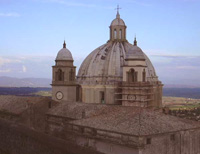 La Chiesa di Santa Margherita |
|
| Celleno |
||
| Celleno is located in the eastern part of the Tuscia area of Viterbo and is set in the countryside dotted with cherry trees. The little church of San Rocco holds several eighteenth-century canvases (Our Lady of the Rosary and a Crucifixion), a fifteenth century wooden crucifix, a cross in gilt silver dating to 1436 and a gilt copper chalice from the fifteenth century. Not far from the town is the eighteenth century convent of San Giovanni Battista that is now used for group accommodation facilities. In the locality of Valle dell'Infernaccio, on the way to Viterbo, nature has "sculpted" one of the area's most charming landscapes. The Infernaccio torrent rushes down a deep gully between basalt walls, tuff and woodlands, creating a breathtaking waterfall. East of Celleno are Grotte Santo Stefano and Castello di Montecalvello. Montecalvello is a small village which lies about 5 km away from Grotte Santo Stefano, and is characterized by the presence of a castle of average size but of great beauty. Castello di Montecalvello belonged to Monaldeschi and was transformed into a palace from the end of'400. In 1970 the castle passed into the hands of the famous painter of contemporary art Conte Balthus Klossowski de Rola. Although Castello di Montecalvello is privately owned , the castle can be visited freely outside. You can go under a short tunnel that leads up to the sacred of the small church that has remained almost intact. Montecalvello |
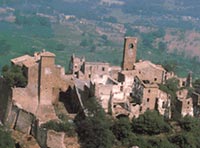 Celleno |
|
| Montecalvello, which rises around a castle where the famous Balthus, a contemporary painter, lived for thirty years. Restored by Count Balthus Klossowski de Rola, the castle is beautifully maintained and still evolving.The studio of Balthus still has canvases on easels and a table where the artist worked. |
||
| Gradoli |
||
| Gradoli is a nice medieval village overlooking the lake of Bolsena. Gradoli's origins can be traced back to the Middle Ages. In the 13th century it was under the rule of the powerful common of Orvieto, while at the half the 16th century it was annexed to the Dukdom of Castro until it fell in the handrs of the Church a century later.
The historical centre is dominated by the impressive Palazzo Farnese, built in 1515 by Antonio Sangallo the Younger: visitors are allowee in the rooms of the palace to view the vivid grattesche decorations, friezes and paintings; in this palace is housed the Museum and Documentary Centre of Farnese Family. |
|
|
| Civita di Bagnoregio |
||
| Civita di Bagnoregio is noted for its striking position atop a plateau of friable volcanic tufa overlooking the Tiber river valley, in constant danger of destruction as its edges fall off, leaving the buildings built on the plateau to crumble. As of 2004, there are plans to reinforce the plateau with steel rods to prevent further geological damage. Civita (city) as the oldest part of Bagnoregio is called, is now completely isolated from the plateau to which it was once united by a ridge. The only access to Civita is through a light modern pedestrian bridge leading to the only remaining gate (Porta di S. Maria). The gate is protected by a tower and it is decorated with reliefs. The city is also much admired for its architecture, some spanning several thousand years. Civita di Bagnoregio owes much of its unaltered condition to its relative isolation: the town was able to withstand most intrusions of modernity as well as the destruction wrought by two world wars.
|
||
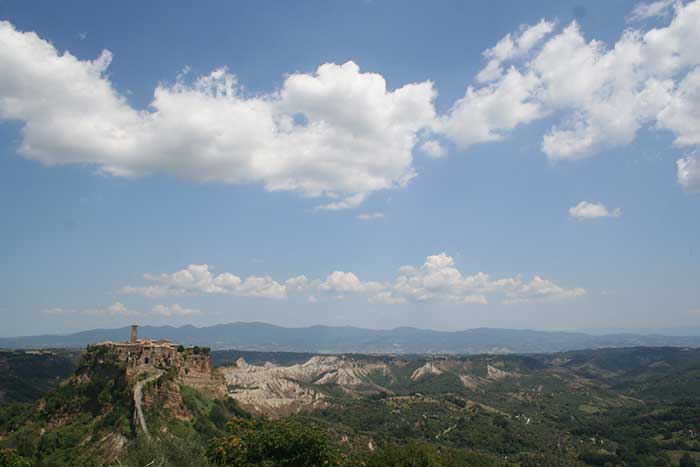 |
||
Civita di Bagnoregio is a magical place and poetically it’s known as the dying town. It was built built about 2,500 years ago by the Etruscans . |
||
|
||
| The Monte Rufeno Natural Reserve covers a surface of 2892 hectares in the Town of Acquapendente, at the border with Umbria and Tuscany. Mixed oak woods dominate the area, where it is also possible to find Mediterranean maquis and reforestations with conifers. It has secular woods housing wildlife including, among the others, boars, eagle owls, turtles and beech martens.
www.parchilazio.it provides good information ans some marked itinertaries. |
|
|
Just a few kilometers from Bolsena is Mezzano lake, in which are preserved the ruins of a semi-submerged town, which lies within and is protected by the Selva del Lamone Regional Il Sentiero dei Briganti (it) |
||
| Bolsena is crossed by the Via Cassia, the ancient Roman road which during the Middle Ages became known as Via Francigena.
The municipalities of the towns of Acquapendente and Bolsena (located at the border between Latium and Tuscany) have restored (for pedestrians only) the old Via Cassia where it diverges from the current one. Via Francigena walks have become very popular among the residents and the many foreigners who live in the area. It takes 8 days to complete the final stage in Lazio. The route passes by Acquapendente formerly known as Acquapendentem, meaning, “pending water.” to arrive at Bolsena. Approaching Proceno, modern day pilgrim hikers leave Tuscany, cross into Lazio, and enter a region sometimes known as Tuscia, the heart of Etruscan empire. Leaving from either Proceno or Acquapendente was the minimal required distance to walk to Rome, in order to receive a Testimonium, a document similar to Compostela that pilgrims in Spain would get. VF - 37 - From Acquapendente to Bolsena | 22.1 km, 05:55 hours | Map After a visit to the Church of Santo Sepolcro (its bright crypt was built in accordance with the church of the same name in the Holy Land) the route continues without problems till San Lorenzo Nuovo, where you can admire views of Lake Bolsena. Going down the volcanic crater, undertake a pleasant route along excavated streets leading to Bolsena, going up and down among olive groves, fields, and forests in the background. Road-houses and water only in San Lorenzo Nuovo. VF - 38 - From Bolsena to Montefiascone | 18.3 km, 05:17 hours | Map Among olive groves and brushes the path detaches from Bolsena and, after going up and down, admiring wonderful sights of the lake, come back to the paving along the ancient Via Cassia. The 360 degree view from the Tower of Pilgrims in Montefiascone is exciting. Pay attention to traffic walking along the tracks between Croce del Pellegrino and Ponte della Regina, Cassia Main Road till Poggio Lungo. Water supply only in the first section of the route. http://www.francigenalazio.it/en/map/wrap/?layer=track.4&id=245 |
||
| Bisentina isle Between Capodimonte and the isle there a ferryboat's service more than once a day on condition to have a minimum number of passengers. The moderate price of this service includes a little excursion on the Bisentina with guided tour to admire, in a little time, the almost uncontaminated nature consisting in thick holm-oak's woods, italian style gardens, the delightful views and numerous monuments, for example the church Santi Giacomo e Cristoforo of Vignola, the franciscan convent, the valuable Rocchina, Santa Caterina temple and the octagonal plan of Sangallo built on an etruscan columbarium that rises from a rock's buttress on the lake; furthermore the Crucifix chapel with its twentieth-century frescos and, the last one, the horrible Malta of the Popes, a prison for the life for clericals accused of heresy, composed by one miserable and dark cell inside a hill with light filtering from a little trap door situated 20 m. high. At the end of the excursion, on the way back, the tour sails panoramically round the isle where the sinuosity of its outlines shows west pleasant smal bays, on the north lies the majestic Tabor mountain, East rocky precipices on the azure lake, on the southern coast, the green area. |
||
|
Enlarge map |
|
Communities of the Province Viterbo | Acquapendente · Arlena di Castro · Bagnoregio · Barbarano Romano · Bassano Romano · Bassano in Teverina · Blera · Bolsena · Bomarzo · Calcata · Canepina · Canino · Capodimonte · Capranica · Caprarola · Carbognano · Castel Sant'Elia · Castiglione in Teverina · Celleno · Cellere · Civita Castellana · Civitella d'Agliano · Corchiano · Fabrica di Roma · Faleria · Farnese · Gallese · Gradoli · Graffignano · Grotte di Castro · Ischia di Castro · Latera · Lubriano · Marta · Montalto di Castro · Monte Romano · Montefiascone · Monterosi · Nepi · Onano · Oriolo Romano · Orte · Piansano · Proceno · Ronciglione · San Lorenzo Nuovo · Soriano nel Cimino · Sutri · Tarquinia · Tessennano · Tuscania · Valentano · Vallerano · Vasanello · Vejano · Vetralla · Vignanello · Villa San Giovanni in Tuscia · Viterbo · Vitorchiano |
Archeonet |
|
Podere Santa Pia, situated in a particularly scenic valley, which overlooks on the hills around Cinigiano, |

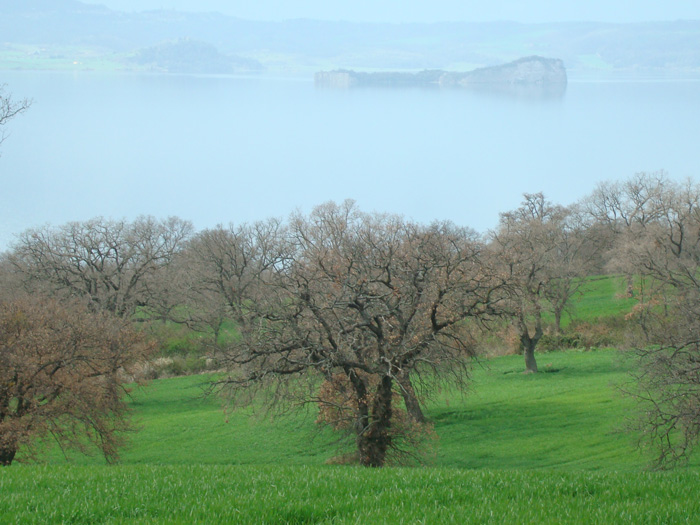
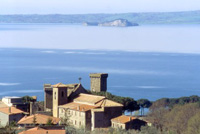
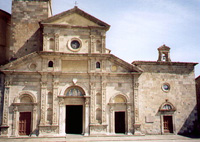



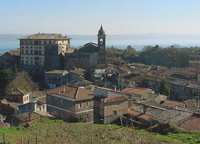 Gradoli
Gradoli